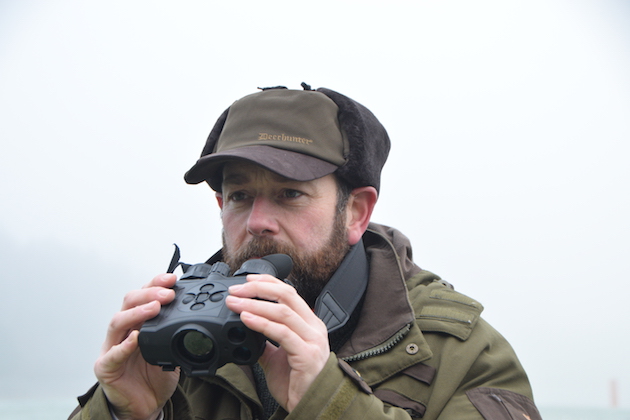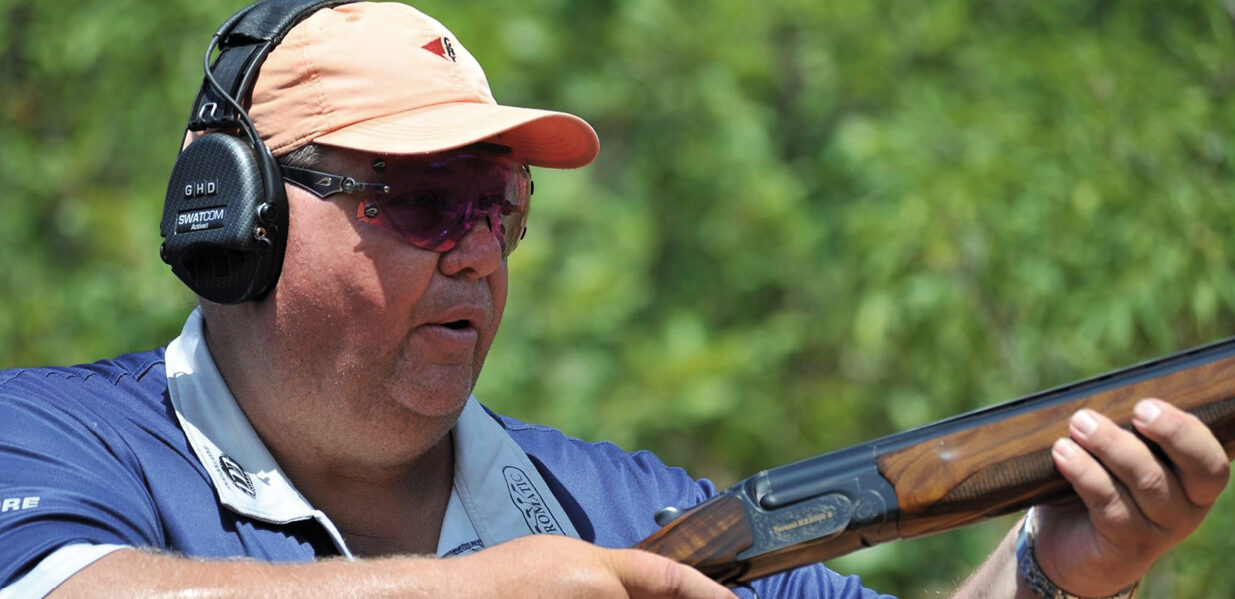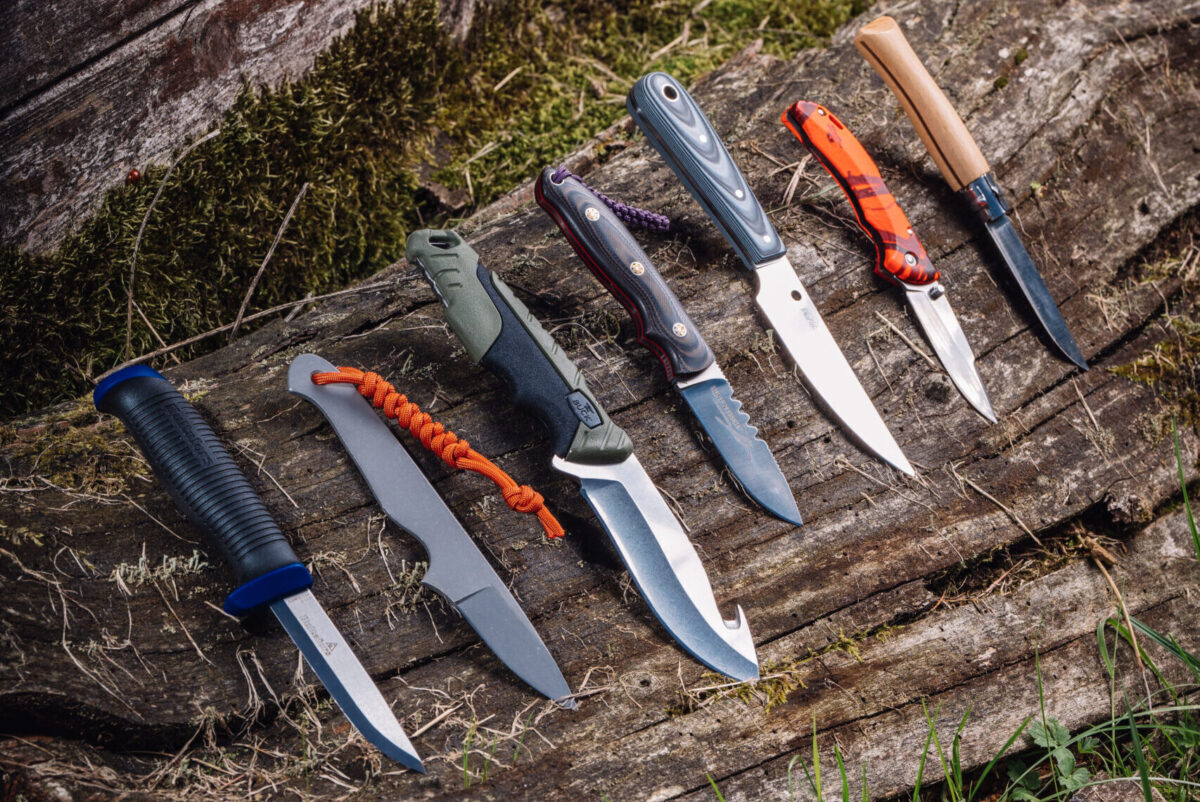New thermal-imaging kit – whether you’re shooting pests or controlling stock levels
The new thermal-imaging kit on the market is invaluable, says Chris Parkin

The X-shaped layout of the button control on the Pulsar Accolade bi-ocular is more comfortable than the older in-line style
There is no doubt that thermal-imaging equipment must be at the forefront of shooting technology. It comes with a moral argument about sporting ethics versus serious vermin control at the buyer’s discretion. But the capability to see quarry species, in conditions once considered unlikely or impossible, is a revelation to those trying it for the first time.
Pulsar is perhaps the best-known brand in the rifle-shooting world for these optical devices to spot animals then aim a shot through the rifle. The uncooled microbolometer sensors that detect the faint traces of heat are incredibly sensitive, yet have now reached a temporary plateau; at the top of the market, the capability has remained constant for the past 12 to 18 months. But the associated ergonomics and electronic tools have been added to and improved.

The XP50 Trail rifle scope has clear and easy-to-navigate menu structures
If anything, the cost of the top models has increased rather than diminished. However, the technology has filtered down to more economic additions to your kit bag. Because it is seen as a fast-evolving market — with new models launched every six months or so — buyers want the new model while ruling out the falling price of what was perfect for them half a season ago.

The Accolade has been cleverly designed with a small cutout to fit the bridge of the nose
Smooth motion
- Pulsar’s XP50 Trail rifle scope and Accolade binoculars use the same thermal core with 640×480-pixel thermal sensor and internal screen resolution. These provide a detection range up to 1,800m on a 1.7m tall object.
- The 50Hz refresh rate ensures smooth motion of whatever is being viewed.
- Onboard photo/video capability is included, with storage and download capability, either wired to a PC or wirelessly via the Stream Vision application on a smartphone or tablet. Either can be used for live display.
- The Accolade binocular — or more correctly bi-ocular — device has the same single objective lens as the Pulsar’s Helion monocular but twin eyepieces allow for a more comfortable field of view on the internal screen. There is a longer-lasting effect on your night vision than simply the immediate narrowing of your pupils from a bright light; you have to deal with it if you want to get the most from the capability offered.
- There is a 2.5-20x magnification with intuitive menu structures to control eight colour palettes, screen brightness, contrast and other factors that can be tuned to meet the requirements of your operating environment.
- The three observation modes in the menu are pre-set values for these controls, so it makes most sense to tailor them to suit. Each eyepiece has individual focal control. The image quality never gets nudged laterally out of position and because they lock more securely into your bony eye sockets, with variable interpupillary distance between them, they focus like the single monocular units.
- Any animal within direct line of sight can be detected in darkness — not forgetting daylight — because the devices detect and process the information into a more recognisable visible picture to the user. Quarry moving through undergrowth or partially obscured by solid objects can be picked up more easily depending on which of the eight colour palettes on the Accolade (or two on the Trail) is used; either white, black or more vivid tones. The white equalling hot gives an image similar to black-and-white television, though the red-hot palette on the Accolade does add a little more definition to the hotter spots on a specific bulk target.
- Range estimation has now been addressed on both these models. The latest LFR addition to either unit is a laser rangefinder that will project a reticule in the binocular or scope to aim and ping the laser. This will display range to target in metres or yards, also compensating for the up- or downhill angle. A secondary scan mode can be applied to make this a continuous process, with range displayed every second.
- Both units have automatic off functions and are controlled with simple intuitive menu structures by the buttons on top, in-line on the Trail or in an “X” layout on the Accolade. Both share the same “language”, so once you are familiar with one the other is straightforward. There are slight differences due to the greater number of colours on the Accolade.
- The Trail has a full zeroing capability with 14 reticule shapes in two colours to coincide your point of aim and impact, once fitted to a rifle.

This fox was shot in daylight at close range with the Trail, it was slumbering close to a chicken farm in long undergrowth, but the thermal image was unmistakable
Undetected by quarry
- The standard unit is supplied with twin claws to attach to a Picatinny rail and other options are available. It can be shared between three rifles, each having a primary zero with five secondary values that allow quick access to longer-range shots, with all usual caution applied.
- Picture-in-picture is a small box in the upper screen with higher magnification, allowing you to keep the overall wide field of view.
- The 1.6x base-level optical magnification on the Trail and 2.5x optical zoom on the Accolade can each be digitally magnified to 12.8 or 20x.
- The deep joy of thermal imaging, as with daylight optics, is that the quarry has no indication of your presence, so you become the ultimate “fly on the wall”.
- At close range relative to the size of the animal, definition is spectacular, even showing thermal variation across bony legs or velvet antlers. As distance increases, the ability to watch animals go about their daily life is the key to identifying what they are. It’s important, especially when making a shot with thermal imaging, not to assume hot is what can be shot. Generally you don’t see what you should avoid, such as small branches or barbed wire. Remember that thermal only shows what you want to hit, not what you need to miss.

The Trail XP50 LRF adopts familiar riflescope ergonomics to that of a regular daylight scope
No problem in fog
Rabbits and hares at up to 600m are visible without any issue, foxes or deer beyond that. When the air is cool and dry, damp air diminishes range and definition but funnily enough, thick fog and mist that would normally end your day, often become quite transparent with thermal imaging.
The 17µm (micrometres) sensor of the XP50 Trail and Accolade is the highest capability Pulsar offers to the civilian market for the greatest level of image definition.
However, depending on your needs, don’t assume the most expensive is the best. There are minor variations across the Pulsar ranges with smaller 38mm objective lenses that may suit your needs better at lower cost, especially in close quarters where low magnification is crucial.
These XP50s both boast fully waterproof IPX7 ratings and the Trail scope automatically turns off if you stand the rifle up above 70° or lay it on its side. It also tells you if you are canting the rifle more than 5° from vertical during the shot.
The rechargeable IPS5, 5.2A-h battery is reliable. Larger IPS10 batteries are available for even longer duration than the solid six to eight hours’ use the standard one allows.
How to choose a stalking rifle
Advice on choosing a rifle and scope
Which is the best night vision scope for the money?
Pulsar’s N550 digital night-vision rifle scope was a game- changer in the world of late-night pest control and subsequent updates have…

Both units can be connected via USB cable to a desktop computer or wirelessly using the Stream Vision app
Thermal-imaging kit – a valuable tool
Thermal imaging is a valuable tool when you consider the time and effort it can save in daily use, the number of animals that can be seen to pursue or counted to assess population levels. If your joy in the sport is purely to hunt, stalk and go head-to-head with the game, thermal may not be for you. When predator control to protect stock is a priority, you can no longer discount thermal imaging as a fashion; it is a seriously capable tool. The capability available is far in excess of what can be shown in a small review, so take any opportunity possible to try some thermal-imaging equipment for yourself.









